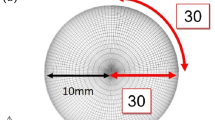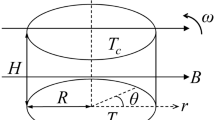Abstract
The Full-Zone model of a liquid bridge encountered in crystal growth is analyzed via linear stability analysis and three-dimensional spectral element simulations, neglecting gravitational forces, for Prandtl number 0.02. The base state is axisymmetric and steady state. Linear stability predicts the character of flow transitions and the value of Re FZ , the thermocapillary Reynolds number, at which instabilities occur. Previous linear stability findings show that application of a steady, axial magnetic field stabilizes the base state. Previous three-dimensional simulations with no magnetic field predict a first transition that agrees well with linear stability theory. However, these simulations also demonstrated that continued time integration at just slightly higher Re FZ leads to what appears to be periodic flow. Closer inspection and comparison with linear stability theory revealed that this apparent periodicity was actually competition between two steady modes with different axial symmetries. Here an axial magnetic field is applied in three-dimensional simulations and it is verified that the magnetic field does have the intended effect of stabilizing the flow and removing modal competition. The azimuthal flow shows excellent agreement with eigenvectors predicted by linear stability theory.
Similar content being viewed by others
References
A. Eyer, R. Nitsche, H. Zimmermann, J. Crystal Growth 47, 219 (1979)
M. Levenstam, G. Amberg, J. Fluid Mech. 297, 357 (1995)
G. Chen, A. Lizee, B. Roux, J. Crystal Growth 180, 638 (1997)
M. Prange, M. Wanschura, H.C. Kuhlmann, H.J. Rath, J. Fluid Mech. 394, 281 (1999)
M. Lappa, Computers Fluids 34, 743 (2005)
O. Bouizi, C. Delcarte, G. Kasperski, Phys. Fluids 19, 114102 (2007)
C.W. Lan, B.C. Yeh, J. Crystal Growth 262, 59 (2004)
C.W. Lan, B.C. Yeh, Fluid Dyn. Mater. Proc. 1, 33 (2005)
B.C. Houchens, J.S. Walker, J. Thermophysics Heat Trans. 137, 186 (2005)
K.E. Davis, Y. Huang, B.C. Houchens, Phys. Fluids (to appear)
Y. Huang, B.C. Houchens, Eur. Phys. J. Special Topics 192, 47 (2011)
Y. Huang, B.C. Houchens, J. Mech. Materials Structures 6, 905 (2011)
A. Patera, J. Comp. Phys. 54, 468 (1984)
Y. Maday, A. Patera, State-of-the-art Surveys Comput. Mech. 1, 71 (1989)
M.O. Deville, P.F. Fischer, E.H. Mund, High-Order Methods for Incompressible Fluid Flow Cambridge University Press, Cambridge, 2004
Author information
Authors and Affiliations
Corresponding authors
Rights and permissions
About this article
Cite this article
Davis, K.E., Huang, Y. & Houchens, B.C. Three-dimensional simulations of instabilities in a Marangoni-driven, low Prandtl number liquid bridge with magnetic stabilization to verify linear stability theory. Eur. Phys. J. Spec. Top. 219, 13–23 (2013). https://doi.org/10.1140/epjst/e2013-01776-4
Received:
Revised:
Published:
Issue Date:
DOI: https://doi.org/10.1140/epjst/e2013-01776-4




